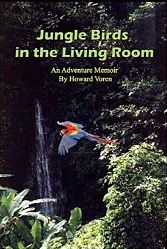Nest Box Interiors – Is Darker Better?
© Howard Voren. Click here to use this content.Q: We have heard that the darker the interior of a nest box the better. We are now using plywood boxes. Although the nest boxes are not very light inside, they could be much darker if we painted the inside black. We have heard that this has been done by some breeders. Does it really make a difference?
A: In my personal opinion, painting the inside of a nest box black is, in most cases, not necessary. In fact, I have strong suspicions that it might have a negative effect on many birds.
The whole idea of creating natural dark interiors in nest boxes was brought about for two reasons: The first was the assumption that a hen would be less likely to be distracted from her sitting responsibilities. The second was the less logical assumption that a female parrot might feel more secure about going to nest in a dark environment.
Although there has never, to my knowledge, been a real scientific study on the subject, it appears from the observations of most professionals that this is true. These discussions took place in the early days of modern psittaculture. This was a time when we used everything from white 10inch PVC pipe to steel grease drums for nest boxes. With this in mind, many have made the mistake of assuming that if a little is good, more is better. You certainly can’t argue with the fact that there is nothing darker than black. What no one bothered to think of was that there might be such a thing as too dark.
The usual natural nesting site of parrots is never black inside. It might be any shade of gray or brown, but never black. Black has a psychological effect on parrots that other backgrounds do not have.
Our research institute has monitored some interesting behavior while photographing young parrots. We chose three different colored drop cloths to use as backgrounds. The colors were white, sky blue and black. We chose material with no sheen to it in order to eliminate reflected glare from the spotlights showing up in the pictures. Of course, the quality of the photos depended in part on all the birds in each group (from two to six) remaining relatively still for a moment. This was not a difficult task against the white and blue backgrounds.
On the other hand, it was so difficult with the black backdrop that we eventually discontinued its use. When the basket of birds was placed in front of the black backdrop, they refused to remain still. Many of them had an uncontrollable desire to walk into the black loth. They did not perceive the black “wall” as a wall. It was perceived as a black hole that they wanted to escape into in order to avoid the bright lights.
Even after they tried to walk into it and failed, they would continue trying. Some would be so insistent that they had to be eliminated from the photo session. All of the birds used for this were hand-raised from the egg. They were never in a nest box, and that year we didn’t brood any of the babies in the dark.
This occurrence tells me that a parrot is instinctively attracted to holes when it seeks to hide. All holes in its natural habitat would appear black from any distance, unless the sun was shining directly into them.
The environment in that hole, however, would not be black. Although parrots are attracted to a circle of black on a tree, once they enter the cavity they settle down in brown, not black. Scientifically, black is black because it absorbs all light. Brown, no matter how dark, does reflect some light.
The birds that we photographed seemed to believe that black was something to run through but not necessarily something to stay in. The fact that some birds kept insisting on trying to walk through the black wall led us to believe that there was also something unsettling about it.
A second experience reinforced this theory. A manufacturer of plastic pet kennels recently came out with some designer colors. One of them was an all-black kennel with a colored door. We made several shipments of birds in them, and we perceived a problem.
It is not uncommon for birds to act unsettled when you pull them out of their cage and put them into a shipping crate. They do, however, always calm down within a reasonable amount of time. In the black crates, they did not settle down in what I would consider a reasonable amount of time. They took about 15 minutes as opposed to the usual five minutes. They also became unsettled to a much greater degree whenever we would move the crate from one place to another.
These experiences tell me that although dark is good, black has the ability of creating undesirable effects. Perhaps the inability to visualize depth is the problem. I would say that the natural color of plywood is just fine. We have bred parrots success fully in everything from white PVC pipe to plywood to steel drums that were painted orange on the inside.
We have never blackened the inside of a nesting box. Due to our observations, it is obvious to us that, psychologically, there is much more to black than what meets the eye.


